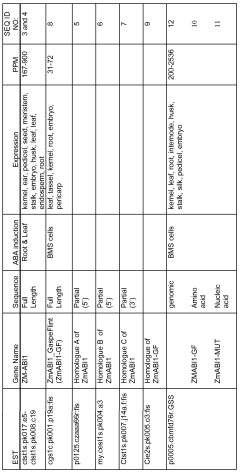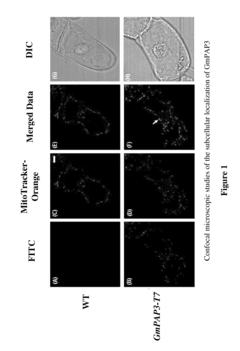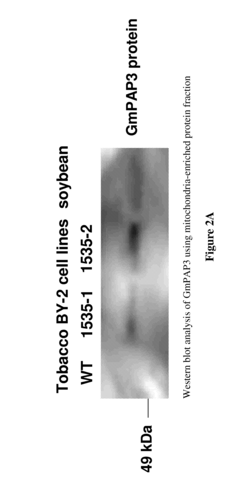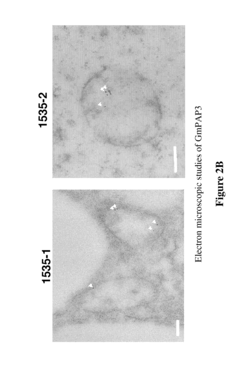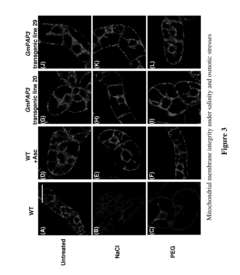Exploring Abscisic Acid-Inspired Methods for Abiotic Stress Alleviation
JUL 14, 20259 MIN READ
Generate Your Research Report Instantly with AI Agent
Patsnap Eureka helps you evaluate technical feasibility & market potential.
ABA-Inspired Stress Alleviation: Background and Objectives
Abscisic acid (ABA) is a plant hormone that plays a crucial role in regulating plant responses to various abiotic stresses, including drought, salinity, and extreme temperatures. The exploration of ABA-inspired methods for abiotic stress alleviation has gained significant attention in recent years due to the increasing challenges posed by climate change and the need for sustainable agriculture.
The development of ABA-inspired stress alleviation techniques has its roots in the discovery of ABA in the 1960s. Since then, researchers have made substantial progress in understanding the molecular mechanisms underlying ABA signaling and its role in stress responses. This knowledge has paved the way for innovative approaches to enhance crop resilience and productivity under adverse environmental conditions.
The primary objective of exploring ABA-inspired methods is to develop novel strategies that mimic or enhance the natural stress response mechanisms in plants. These approaches aim to improve crop tolerance to abiotic stresses without compromising yield or quality. By leveraging the insights gained from ABA research, scientists seek to create more resilient and adaptable crop varieties that can thrive in challenging environments.
One of the key trends in this field is the development of synthetic ABA analogs and agonists that can activate ABA signaling pathways more effectively than the natural hormone. These compounds offer the potential for precise control over plant stress responses, allowing for targeted interventions at critical growth stages or during specific stress events.
Another emerging area of interest is the manipulation of ABA biosynthesis and catabolism pathways to optimize stress responses. By fine-tuning the levels of ABA and its metabolites, researchers aim to enhance plant tolerance to multiple stresses while minimizing any negative impacts on growth and development.
The exploration of ABA-inspired methods also extends to the realm of genetic engineering and biotechnology. Scientists are investigating ways to modify ABA receptors, signaling components, and downstream effectors to create plants with improved stress tolerance. This includes the development of transgenic crops with enhanced ABA sensitivity or altered ABA-responsive gene expression patterns.
As the field progresses, there is a growing focus on integrating ABA-inspired approaches with other stress alleviation strategies, such as the use of beneficial microorganisms, nanotechnology, and precision agriculture techniques. This holistic approach aims to create comprehensive solutions that address the complex nature of abiotic stress in agricultural systems.
The development of ABA-inspired stress alleviation techniques has its roots in the discovery of ABA in the 1960s. Since then, researchers have made substantial progress in understanding the molecular mechanisms underlying ABA signaling and its role in stress responses. This knowledge has paved the way for innovative approaches to enhance crop resilience and productivity under adverse environmental conditions.
The primary objective of exploring ABA-inspired methods is to develop novel strategies that mimic or enhance the natural stress response mechanisms in plants. These approaches aim to improve crop tolerance to abiotic stresses without compromising yield or quality. By leveraging the insights gained from ABA research, scientists seek to create more resilient and adaptable crop varieties that can thrive in challenging environments.
One of the key trends in this field is the development of synthetic ABA analogs and agonists that can activate ABA signaling pathways more effectively than the natural hormone. These compounds offer the potential for precise control over plant stress responses, allowing for targeted interventions at critical growth stages or during specific stress events.
Another emerging area of interest is the manipulation of ABA biosynthesis and catabolism pathways to optimize stress responses. By fine-tuning the levels of ABA and its metabolites, researchers aim to enhance plant tolerance to multiple stresses while minimizing any negative impacts on growth and development.
The exploration of ABA-inspired methods also extends to the realm of genetic engineering and biotechnology. Scientists are investigating ways to modify ABA receptors, signaling components, and downstream effectors to create plants with improved stress tolerance. This includes the development of transgenic crops with enhanced ABA sensitivity or altered ABA-responsive gene expression patterns.
As the field progresses, there is a growing focus on integrating ABA-inspired approaches with other stress alleviation strategies, such as the use of beneficial microorganisms, nanotechnology, and precision agriculture techniques. This holistic approach aims to create comprehensive solutions that address the complex nature of abiotic stress in agricultural systems.
Market Analysis for ABA-Based Agricultural Solutions
The market for ABA-based agricultural solutions is experiencing significant growth, driven by increasing global food demand and the need for crops resilient to abiotic stresses. As climate change intensifies, farmers are seeking innovative methods to protect their yields from extreme weather conditions, soil salinity, and drought. This has created a fertile ground for ABA-inspired technologies to flourish.
The global market for plant growth regulators, which includes ABA-based solutions, is projected to expand substantially in the coming years. This growth is particularly pronounced in regions prone to abiotic stresses, such as parts of Asia, Africa, and the Middle East. North America and Europe are also showing increased interest, as farmers look to optimize crop yields in the face of unpredictable weather patterns.
Key market segments for ABA-based solutions include row crops, fruits and vegetables, and ornamental plants. Among these, row crops represent the largest market share due to their extensive cultivation and economic importance. However, the fruits and vegetables segment is expected to show the highest growth rate, as producers seek to maintain quality and extend shelf life in high-value crops.
The adoption of ABA-inspired technologies varies across different crop types. Cereals, such as wheat and rice, are major targets for abiotic stress alleviation solutions, given their critical role in global food security. High-value crops like tomatoes, peppers, and berries are also significant markets, as producers aim to protect their investments from environmental stresses.
Market trends indicate a shift towards integrated crop management solutions that combine ABA-inspired technologies with other stress-mitigation strategies. This holistic approach is gaining traction among farmers looking for comprehensive solutions to complex environmental challenges.
The competitive landscape is characterized by a mix of established agrochemical companies and innovative startups. Major players are investing heavily in R&D to develop novel ABA-based formulations and application methods. Collaborations between research institutions and industry are accelerating the commercialization of new technologies in this space.
Regulatory environments play a crucial role in market development. As governments worldwide emphasize sustainable agriculture, there is growing support for environmentally friendly crop protection solutions. This trend favors ABA-based products, which are generally perceived as more sustainable alternatives to traditional chemical interventions.
Consumer preferences are also shaping the market, with increasing demand for organic and sustainably produced food. This creates opportunities for ABA-inspired solutions that can enhance crop resilience without leaving harmful residues.
The global market for plant growth regulators, which includes ABA-based solutions, is projected to expand substantially in the coming years. This growth is particularly pronounced in regions prone to abiotic stresses, such as parts of Asia, Africa, and the Middle East. North America and Europe are also showing increased interest, as farmers look to optimize crop yields in the face of unpredictable weather patterns.
Key market segments for ABA-based solutions include row crops, fruits and vegetables, and ornamental plants. Among these, row crops represent the largest market share due to their extensive cultivation and economic importance. However, the fruits and vegetables segment is expected to show the highest growth rate, as producers seek to maintain quality and extend shelf life in high-value crops.
The adoption of ABA-inspired technologies varies across different crop types. Cereals, such as wheat and rice, are major targets for abiotic stress alleviation solutions, given their critical role in global food security. High-value crops like tomatoes, peppers, and berries are also significant markets, as producers aim to protect their investments from environmental stresses.
Market trends indicate a shift towards integrated crop management solutions that combine ABA-inspired technologies with other stress-mitigation strategies. This holistic approach is gaining traction among farmers looking for comprehensive solutions to complex environmental challenges.
The competitive landscape is characterized by a mix of established agrochemical companies and innovative startups. Major players are investing heavily in R&D to develop novel ABA-based formulations and application methods. Collaborations between research institutions and industry are accelerating the commercialization of new technologies in this space.
Regulatory environments play a crucial role in market development. As governments worldwide emphasize sustainable agriculture, there is growing support for environmentally friendly crop protection solutions. This trend favors ABA-based products, which are generally perceived as more sustainable alternatives to traditional chemical interventions.
Consumer preferences are also shaping the market, with increasing demand for organic and sustainably produced food. This creates opportunities for ABA-inspired solutions that can enhance crop resilience without leaving harmful residues.
Current Challenges in ABA-Inspired Stress Mitigation
Despite the promising potential of abscisic acid (ABA)-inspired methods for abiotic stress alleviation in plants, several significant challenges persist in this field of research and application. One of the primary obstacles is the complexity of ABA signaling pathways and their interactions with other plant hormones and stress response mechanisms. This intricate network of molecular interactions makes it difficult to predict and control the effects of ABA-inspired interventions across different plant species and environmental conditions.
Another major challenge lies in the development of stable and effective ABA analogs or mimics. While natural ABA is highly potent, it is also rapidly metabolized in plants, limiting its practical application. Synthetic ABA analogs often struggle to match the efficacy of the natural hormone while maintaining stability and bioavailability. Additionally, the cost-effective production of these compounds at scale remains a significant hurdle for widespread agricultural implementation.
The specificity of ABA-inspired treatments poses another challenge. Different types of abiotic stresses, such as drought, salinity, and extreme temperatures, may require tailored approaches. Developing universal solutions that can address multiple stress factors simultaneously without compromising plant growth and yield is a complex task that researchers are still grappling with.
Furthermore, the translation of laboratory findings to field applications presents its own set of challenges. Environmental variables in real-world agricultural settings can significantly impact the effectiveness of ABA-inspired treatments. Factors such as soil composition, microbiome interactions, and fluctuating weather conditions can all influence the uptake, distribution, and efficacy of these compounds within plants.
The potential for unintended consequences also remains a concern. While ABA-inspired methods aim to enhance stress tolerance, they may inadvertently affect other aspects of plant physiology, such as growth rates, flowering times, or fruit development. Striking the right balance between stress protection and maintaining optimal plant productivity is crucial for the successful implementation of these technologies.
Regulatory hurdles and public perception present additional challenges to the widespread adoption of ABA-inspired stress mitigation strategies. Stringent safety assessments and approval processes for new agricultural technologies can significantly delay their implementation. Moreover, public concerns about the use of synthetic compounds or genetic modifications in food production may impact the acceptance of these innovative approaches.
Another major challenge lies in the development of stable and effective ABA analogs or mimics. While natural ABA is highly potent, it is also rapidly metabolized in plants, limiting its practical application. Synthetic ABA analogs often struggle to match the efficacy of the natural hormone while maintaining stability and bioavailability. Additionally, the cost-effective production of these compounds at scale remains a significant hurdle for widespread agricultural implementation.
The specificity of ABA-inspired treatments poses another challenge. Different types of abiotic stresses, such as drought, salinity, and extreme temperatures, may require tailored approaches. Developing universal solutions that can address multiple stress factors simultaneously without compromising plant growth and yield is a complex task that researchers are still grappling with.
Furthermore, the translation of laboratory findings to field applications presents its own set of challenges. Environmental variables in real-world agricultural settings can significantly impact the effectiveness of ABA-inspired treatments. Factors such as soil composition, microbiome interactions, and fluctuating weather conditions can all influence the uptake, distribution, and efficacy of these compounds within plants.
The potential for unintended consequences also remains a concern. While ABA-inspired methods aim to enhance stress tolerance, they may inadvertently affect other aspects of plant physiology, such as growth rates, flowering times, or fruit development. Striking the right balance between stress protection and maintaining optimal plant productivity is crucial for the successful implementation of these technologies.
Regulatory hurdles and public perception present additional challenges to the widespread adoption of ABA-inspired stress mitigation strategies. Stringent safety assessments and approval processes for new agricultural technologies can significantly delay their implementation. Moreover, public concerns about the use of synthetic compounds or genetic modifications in food production may impact the acceptance of these innovative approaches.
Existing ABA-Inspired Stress Alleviation Strategies
01 Abscisic acid-inspired compounds for abiotic stress tolerance
Development of synthetic compounds inspired by abscisic acid structure to enhance plant tolerance to various abiotic stresses such as drought, salinity, and extreme temperatures. These compounds mimic the effects of natural abscisic acid in regulating plant responses to environmental stresses.- Abscisic acid-inspired compounds for abiotic stress tolerance: Development of synthetic compounds inspired by abscisic acid structure to enhance plant tolerance to various abiotic stresses such as drought, salinity, and extreme temperatures. These compounds mimic the effects of natural abscisic acid in regulating plant stress responses and improving crop resilience.
- Genetic modification for enhanced abscisic acid signaling: Genetic engineering approaches to modify plant genes involved in abscisic acid biosynthesis, perception, or signaling pathways. These modifications aim to improve plant responses to abiotic stresses by enhancing abscisic acid-mediated stress tolerance mechanisms.
- Exogenous application of abscisic acid and derivatives: Methods for external application of abscisic acid or its derivatives to plants or seeds to induce stress tolerance. This approach involves optimizing application timing, dosage, and formulation to effectively trigger plant stress responses and improve crop performance under adverse conditions.
- Abscisic acid-responsive promoters for stress-inducible gene expression: Development of stress-inducible promoter systems based on abscisic acid-responsive elements. These promoters allow for targeted expression of stress tolerance genes in response to abiotic stress conditions, improving plant adaptation without compromising growth under normal conditions.
- Abscisic acid crosstalk with other phytohormones for stress alleviation: Investigation of the interactions between abscisic acid and other plant hormones in regulating abiotic stress responses. This approach aims to develop strategies that leverage hormone crosstalk to enhance overall plant stress tolerance and resilience.
02 Genetic modification for improved stress response
Genetic engineering techniques to modify plants for enhanced production or sensitivity to abscisic acid, leading to improved abiotic stress tolerance. This includes the introduction of genes involved in abscisic acid biosynthesis, signaling, or response pathways.Expand Specific Solutions03 Exogenous application of abscisic acid and analogs
Methods for external application of abscisic acid or its synthetic analogs to plants to induce stress tolerance. This includes various formulations and application techniques to enhance the efficacy of these compounds in alleviating abiotic stress effects.Expand Specific Solutions04 Abscisic acid signaling pathway modulation
Strategies to manipulate the abscisic acid signaling pathway in plants, including modification of receptor proteins, transcription factors, or other signaling components. This approach aims to enhance plant responsiveness to abscisic acid and improve stress tolerance mechanisms.Expand Specific Solutions05 Combination of abscisic acid with other stress-alleviating agents
Development of synergistic approaches combining abscisic acid or its analogs with other stress-alleviating compounds or techniques. This includes the use of compatible solutes, antioxidants, or other phytohormones to enhance overall plant stress tolerance.Expand Specific Solutions
Key Players in ABA-Inspired Crop Protection
The exploration of abscisic acid-inspired methods for abiotic stress alleviation is in a nascent stage, with significant potential for growth. The market is expanding as agricultural challenges due to climate change increase. While the technology is still developing, several key players are making strides. Companies like Evogene Ltd., Valent BioSciences Corp., and BASF Plant Science LLC are at the forefront, leveraging their expertise in plant biotechnology. Academic institutions such as the University of California and the Chinese University of Hong Kong are contributing valuable research. The competitive landscape is diverse, with both established agrochemical companies and innovative startups vying for market share in this promising field.
Evogene Ltd.
Technical Solution: Evogene Ltd. has developed a computational biology platform called GeneRator AI for discovering novel genes and genetic elements related to abiotic stress tolerance. Their approach involves using machine learning algorithms to analyze large genomic datasets and predict genes that may confer drought, heat, or salinity tolerance[1]. The company has successfully identified several candidate genes that, when expressed in model plants, have shown improved stress tolerance in controlled experiments[2]. Evogene's technology also includes the development of microRNA regulators that can modulate the expression of multiple stress-related genes simultaneously, potentially offering a more comprehensive approach to abiotic stress alleviation[3].
Strengths: Advanced AI-driven gene discovery platform, proven success in identifying stress-tolerant genes. Weaknesses: Regulatory hurdles for genetically modified crops, potential public resistance to GM technology.
BASF Corp.
Technical Solution: BASF Corp. has developed a multi-faceted approach to abiotic stress alleviation inspired by abscisic acid (ABA) signaling pathways. Their research focuses on developing synthetic ABA analogs that can activate stress response pathways more effectively than natural ABA[4]. These compounds have shown promise in improving drought tolerance in various crops without the rapid degradation issues associated with ABA itself. Additionally, BASF has invested in the development of novel formulations that enhance the uptake and distribution of these ABA-inspired compounds within plants, improving their efficacy and reducing the required application rates[5]. The company is also exploring the use of biostimulants that can enhance endogenous ABA production and signaling in plants, providing a non-GM approach to stress tolerance[6].
Strengths: Diverse portfolio of chemical and biological solutions, strong R&D capabilities. Weaknesses: Potential environmental concerns about synthetic compounds, variability in efficacy across different crop species and environments.
Innovative ABA Analogs and Signaling Pathways
Zea mays ABA signaling genes and methods of use
PatentWO2009102971A1
Innovation
- Genetic modification of plants by introducing DNA sequences that disrupt or delay ABA signaling or perception, specifically using ABA-associated sequences such as mutants, fragments, and antisense nucleotides to modulate ABA sensitivity in a tissue- and developmentally-specific manner, thereby protecting plants from stress.
Method to alleviate abiotic stress in plants by expression of mitochondrial-targeted purple acid phosphatase
PatentInactiveUS7939712B2
Innovation
- Targeting the mitochondria with a purple acid phosphatase (PAP) protein, specifically the GmPAP3-encoded protein, to mitigate ROS accumulation and enhance cellular resilience by modifying plant cells to express this protein, thereby increasing mitochondrial integrity and reducing lipid peroxidation.
Environmental Impact of ABA-Inspired Technologies
The environmental impact of ABA-inspired technologies for abiotic stress alleviation in plants is a critical consideration in their development and implementation. These technologies, which mimic the effects of abscisic acid (ABA) in plants, have the potential to significantly reduce water consumption in agriculture while improving crop yields under stress conditions.
One of the primary environmental benefits of ABA-inspired technologies is their potential to enhance water use efficiency in agriculture. By enabling plants to better tolerate drought conditions, these technologies can reduce the need for irrigation, thereby conserving water resources. This is particularly important in regions facing water scarcity, where sustainable water management is crucial for long-term agricultural viability.
Furthermore, the improved stress tolerance conferred by ABA-inspired technologies may lead to reduced use of chemical pesticides and fertilizers. Plants that are better equipped to handle abiotic stresses are generally more resistant to pests and diseases, potentially decreasing the reliance on chemical interventions. This reduction in agrochemical use can have positive effects on soil health, biodiversity, and overall ecosystem balance.
However, the widespread adoption of ABA-inspired technologies may also have some potential negative environmental impacts that need to be carefully considered. For instance, the introduction of stress-tolerant crops might lead to agricultural expansion into marginal lands that were previously unsuitable for cultivation. This could result in habitat loss and increased pressure on natural ecosystems if not managed responsibly.
Another consideration is the potential for unintended ecological consequences. Altering plant responses to environmental stresses could impact plant-insect interactions, pollination patterns, and overall ecosystem dynamics. Long-term studies will be necessary to fully understand these potential ecological shifts and their implications for biodiversity and ecosystem services.
The production and application of ABA-inspired compounds or technologies may also have environmental implications. It is crucial to assess the environmental footprint of manufacturing these compounds, including energy consumption, waste generation, and potential chemical pollution. Sustainable production methods and proper disposal protocols should be developed to minimize any negative environmental impacts.
In conclusion, while ABA-inspired technologies offer promising solutions for abiotic stress alleviation in agriculture, their environmental impact must be carefully evaluated and managed. Balancing the benefits of improved crop resilience and resource efficiency with potential ecological risks will be key to ensuring the sustainable implementation of these innovative approaches in global agriculture.
One of the primary environmental benefits of ABA-inspired technologies is their potential to enhance water use efficiency in agriculture. By enabling plants to better tolerate drought conditions, these technologies can reduce the need for irrigation, thereby conserving water resources. This is particularly important in regions facing water scarcity, where sustainable water management is crucial for long-term agricultural viability.
Furthermore, the improved stress tolerance conferred by ABA-inspired technologies may lead to reduced use of chemical pesticides and fertilizers. Plants that are better equipped to handle abiotic stresses are generally more resistant to pests and diseases, potentially decreasing the reliance on chemical interventions. This reduction in agrochemical use can have positive effects on soil health, biodiversity, and overall ecosystem balance.
However, the widespread adoption of ABA-inspired technologies may also have some potential negative environmental impacts that need to be carefully considered. For instance, the introduction of stress-tolerant crops might lead to agricultural expansion into marginal lands that were previously unsuitable for cultivation. This could result in habitat loss and increased pressure on natural ecosystems if not managed responsibly.
Another consideration is the potential for unintended ecological consequences. Altering plant responses to environmental stresses could impact plant-insect interactions, pollination patterns, and overall ecosystem dynamics. Long-term studies will be necessary to fully understand these potential ecological shifts and their implications for biodiversity and ecosystem services.
The production and application of ABA-inspired compounds or technologies may also have environmental implications. It is crucial to assess the environmental footprint of manufacturing these compounds, including energy consumption, waste generation, and potential chemical pollution. Sustainable production methods and proper disposal protocols should be developed to minimize any negative environmental impacts.
In conclusion, while ABA-inspired technologies offer promising solutions for abiotic stress alleviation in agriculture, their environmental impact must be carefully evaluated and managed. Balancing the benefits of improved crop resilience and resource efficiency with potential ecological risks will be key to ensuring the sustainable implementation of these innovative approaches in global agriculture.
Regulatory Framework for ABA-Based Agricultural Products
The regulatory framework for ABA-based agricultural products is a critical aspect of their development and commercialization. As these products gain traction in the agricultural sector, governments and regulatory bodies are establishing guidelines to ensure their safe and effective use. The framework typically encompasses several key areas, including product registration, safety assessments, efficacy testing, and labeling requirements.
Product registration is often the first step in the regulatory process. Manufacturers must submit detailed information about the ABA-based product, including its composition, intended use, and production methods. This registration process helps regulatory agencies maintain oversight and ensure that only approved products enter the market.
Safety assessments form a crucial component of the regulatory framework. These evaluations examine the potential impacts of ABA-based products on human health, non-target organisms, and the environment. Toxicological studies, environmental fate analyses, and ecological risk assessments are typically required to demonstrate the product's safety profile.
Efficacy testing is another essential element of the regulatory process. Manufacturers must provide evidence that their ABA-based products effectively alleviate abiotic stress in target crops. This often involves field trials under various environmental conditions to demonstrate the product's performance and reliability.
Labeling requirements are designed to ensure that farmers and agricultural professionals have access to accurate and comprehensive information about ABA-based products. Labels must typically include details on application rates, timing, target crops, and any potential restrictions or precautions.
The regulatory framework also addresses issues related to residue limits and pre-harvest intervals. These regulations aim to protect consumers by establishing maximum allowable levels of ABA residues in harvested crops and specifying the minimum time between product application and harvest.
As the field of ABA-inspired stress alleviation methods evolves, regulatory frameworks are adapting to keep pace with technological advancements. Many countries are developing specific guidelines for plant growth regulators and biostimulants, categories that often include ABA-based products. These guidelines aim to streamline the approval process while maintaining rigorous safety and efficacy standards.
International harmonization efforts are underway to facilitate global trade in ABA-based agricultural products. Organizations such as the OECD and FAO are working to develop common data requirements and assessment methodologies, which could help reduce regulatory barriers between countries and accelerate the adoption of these innovative stress-mitigation technologies.
Product registration is often the first step in the regulatory process. Manufacturers must submit detailed information about the ABA-based product, including its composition, intended use, and production methods. This registration process helps regulatory agencies maintain oversight and ensure that only approved products enter the market.
Safety assessments form a crucial component of the regulatory framework. These evaluations examine the potential impacts of ABA-based products on human health, non-target organisms, and the environment. Toxicological studies, environmental fate analyses, and ecological risk assessments are typically required to demonstrate the product's safety profile.
Efficacy testing is another essential element of the regulatory process. Manufacturers must provide evidence that their ABA-based products effectively alleviate abiotic stress in target crops. This often involves field trials under various environmental conditions to demonstrate the product's performance and reliability.
Labeling requirements are designed to ensure that farmers and agricultural professionals have access to accurate and comprehensive information about ABA-based products. Labels must typically include details on application rates, timing, target crops, and any potential restrictions or precautions.
The regulatory framework also addresses issues related to residue limits and pre-harvest intervals. These regulations aim to protect consumers by establishing maximum allowable levels of ABA residues in harvested crops and specifying the minimum time between product application and harvest.
As the field of ABA-inspired stress alleviation methods evolves, regulatory frameworks are adapting to keep pace with technological advancements. Many countries are developing specific guidelines for plant growth regulators and biostimulants, categories that often include ABA-based products. These guidelines aim to streamline the approval process while maintaining rigorous safety and efficacy standards.
International harmonization efforts are underway to facilitate global trade in ABA-based agricultural products. Organizations such as the OECD and FAO are working to develop common data requirements and assessment methodologies, which could help reduce regulatory barriers between countries and accelerate the adoption of these innovative stress-mitigation technologies.
Unlock deeper insights with Patsnap Eureka Quick Research — get a full tech report to explore trends and direct your research. Try now!
Generate Your Research Report Instantly with AI Agent
Supercharge your innovation with Patsnap Eureka AI Agent Platform!


